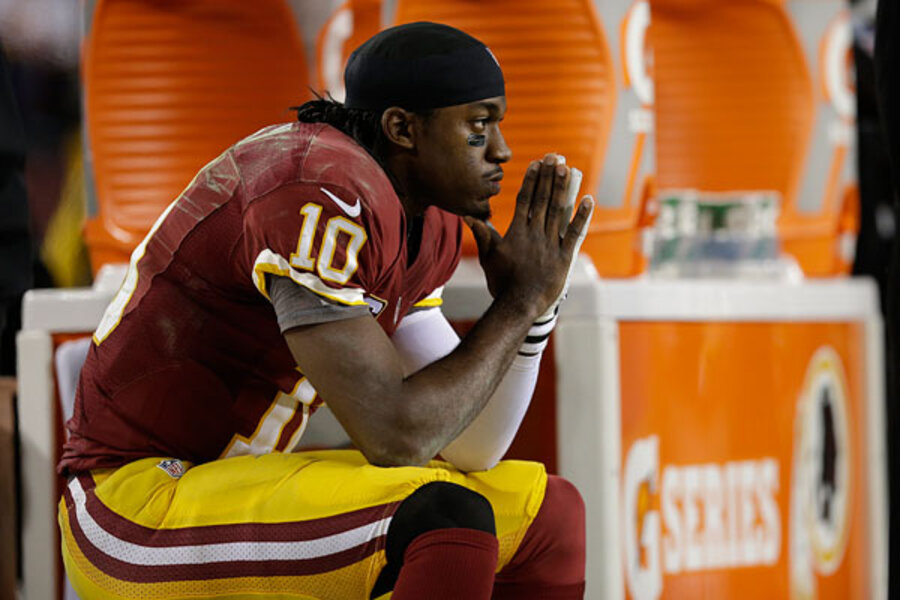Robert Griffin III: RG3 knee injury a warning sign for his future?
Just in case any of us were in doubt, Sunday provided irrefutable evidence that Robert Griffin III's right knee is a national treasure. President Obama should assign a Special Forces team to protect it. Congress should check the fine print to make sure it is not in the sequester. The Smithsonian should reserve a wing.
Because without it, the most exciting player in pro football looked terrifyingly pedestrian.
For the best part of this National Football League season, the sporting world has stood slack-jawed at what the future held in store. However brilliant the present – however awesome Griffin's talents, however inconceivable his speed – it was merely the downpayment for a generation of greatness to come.
For years, Griffin would do battle with fellow rookies Andrew Luck and Russell Wilson. Over the course of a career, he would redefine the quarterback position with his loping grace, his pinpoint passing precision, his Indy-car acceleration. We salivated at the prospect that, delectably, the best was ahead.
That future still remains. But in the wake of the Washington Redskins' 24-14 loss to the Seattle Seahawks Sunday, it cannot help but feel a bit more fragile.
Two plays after Griffin appeared to reinjure an already tender knee in the first quarter, he threw a four-yard touchdown pass. To that point, the Redskins had 14 points and 135 yards of offense. Over the remaining 51:36 of the game, they would add only 69 yards and never again cross midfield.
After the game, Griffin said the knee did not affect his ability to throw. If that is true, it is an indictment in itself, suggesting that, without his mobility to fall back on, Griffin needs to make significant progress as a passer. More likely, he was taking one for the team – playing when he should not have been on the field.
But that raises its own questions. Griffin tweaked his knee in the first quarter and then injured it further in the fourth – to the point where he finally did come out – without being touched by a defender either time. And this was three weeks after suffering what doctors called one of the milder knee strains possible.
Is this what a Griffin career will look like: Moments of incandescence dimmed by the beating his body will take as he scampers on one of his signature runs?
But how can he stop running?
Perhaps, over time, he can develop into an elite pocket passer. Ten years from now, his struggles to be an effective passer against a fearsome Seahawk defense Sunday will simply be remembered as a typical rookie's growing pains. His intelligence, arm, and attitude suggest he has the ability to succeed long-term, regardless of his knees.
But is that what we want?
Is that why Griffin's jersey was the most popular in the NFL this year?
As impressive as his mind and arm are, Griffin's legs are what make him extraordinary. Take away the image of him freezing the defensive end with a loose-limbed juke and sprinting for daylight down the sideline, chased only by his own contrails, and he would seem diminished, whatever his future success.
This is why Redskins coach Mike Shanahan will have much to answer for in the days ahead. By keeping Griffin on the field when he was so obviously struggling was to risk something of incomparable price – Griffin's NFL future – for one week of bragging rights. (The Redskins, after all, were never going to win the Super Bowl this year.)
It's as if Mr. Obama decided to use the Declaration of Independence as a scratch pad because he ran out of Post-It Notes.
But what can be done? Let Griffin play wrapped in bubble wrap and cotton balls? Put a team of snipers in the seats at FedEx Field?
The NFL can do everything in its power to protect quarterbacks (and does), but it can't protect them from themselves. This is why Griffin would have been well-served looking across the field at the other rookie quarterback on display in Washington Sunday.
While not as electrifying as Griffin, the Seahawks' Russell Wilson has a similar skill-set. But he rarely takes big hits, even on designed runs. Yes, that means giving up extra yards – running out of bounds or sliding. But it also means keeping at bay linebackers tasked with breaking you in half.
So far, that has seemed something that Griffin's competitive nature cannot accept. But Wilson is no less competitive. He just realizes that sacrificing a few yards is better for his team than getting knocked down – and perhaps not getting back up for the next play.
If nothing else, Sunday should convince Griffin that the same is true for him.





